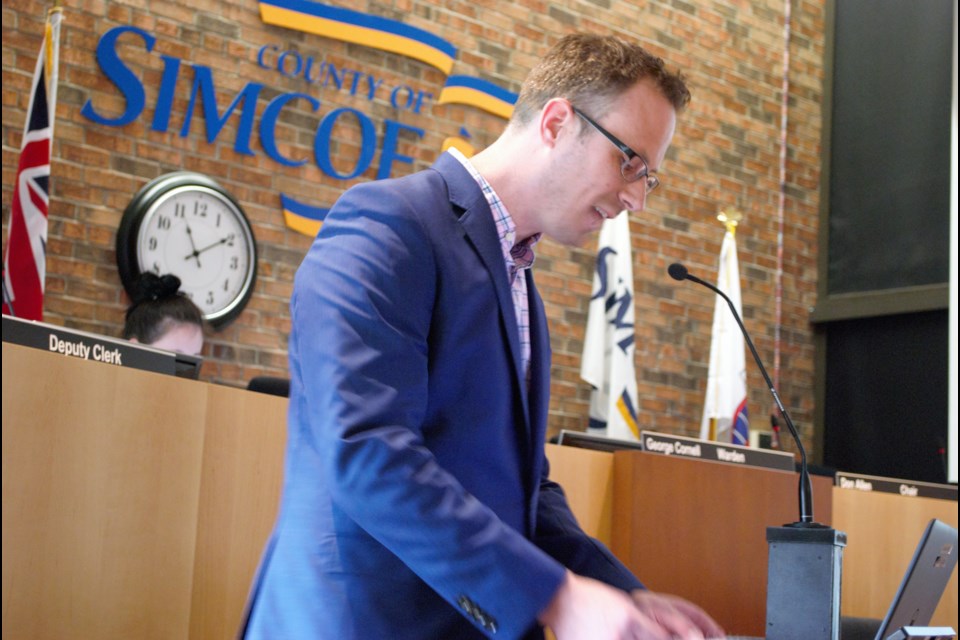Taxes, conservation, development and farming were just some of the topics covered on Monday afternoon in County of Simcoe council chambers.
The two special advisors for the province’s regional governance review, Michael Fenn and Ken Seiling, were in Midhurst to hear from residents from across the county on what they really think of how their government is working.
And the residents of Simcoe County didn’t hold back.
“I moved back to Bradford West Gwillimbury in 2016. I took an interest in municipal politics the day I received my first property tax bill,” said Rick Turner, a resident of Bradford West Gwillimbury. “I was bewildered and astonished at the difference I would be paying in Simcoe County versus Toronto.”
Turner said that after some investigation, he found he was satisfied with the municipality’s budget, but was disheartened that nearly 30 per cent of his tax bill went to the County of Simcoe.
Advisor Ken Seiling pushed back on some of Turner’s assertions.
“I was a little curious about your statement that your taxes are higher than they were in Toronto, because that’s true of almost everybody that lives outside of Toronto,” said Seiling. “I think you’re in the same boat as most people across Ontario.”
Turner agreed with the idea that county council should be taken down to 16 councillors.
“I think 32 is bloated, inefficient and also redundant,” he said.
He also suggested a more transparent budgeting system and for public deputations to be added to county council meetings. Turner’s last suggestion was that it should be easier for municipalities to separate should they so choose.
George Vadeboncoeur, chief administrative officer of the Town of Wasaga Beach and the second to speak, said his general feeling is that the two-tier structure in Simcoe County works well.
“Services, for the most part, are allocated appropriately between the upper and lower tiers,” he said.
He brought forward many ideas on behalf of the Town of Wasaga Beach.
Vadeboncoeur suggested that councils sitting at nine members should be reduced to seven.
He also pointed out there is some duplication of responsibilities between the Nottawasaga Conservation Authority and the Lake Simcoe Regional Conservation Authority, and suggested some responsibilities of those organizations could be taken on at the county level.
He also floated the idea that the county should be providing water and wastewater services.
“The Town of Wasaga Beach does not support restructuring or amalgamation of municipalities,” said Vadeboncoeur, adding that keeping the county structure as-is has benefits such as having a greater borrowing capacity for larger infrastructure projects.
Kenneth Hale, president of the Georgian Triangle Development Institute is a licensed professional planner and spoke on the importance of the special needs of the towns of Blue Mountains, Collingwood, Wasaga Beach and Clearview Township as being adjacent to Georgian Bay.
“The reason we are here today is to convey to the special advisors that the current, antiquated county boundary structure is an inefficient hindrance to the development of our region,” said Hale.
Hale said that the four municipalities that surround the Georgian Bay share characteristics that should define them as their own region.
“We share many of the same values, culture and community organizations, markets, tourism strategies and resources,” he said.
In keeping the four municipalities separate, Hale pointed to inefficiencies in planning processes that makes it difficult for development in the area and has led to the municipalities competing with each other over issues that could have been decided on together.
“Recent examples include a regional airport, hospital expansion, a casino and schools,” he said. “This competition is not healthy, nor is it efficient.”
Paul Maurice, of the Simcoe County Federation of Agriculture, said he felt the county system works efficiently.
He suggested adding an agricultural advisory committee and possibly incorporating a community plan for farmland preservation.
In an interview with BarrieToday, Ken Seiling said that Simcoe County is a bit different from the other regions they’re reviewing.
“Simcoe County is unique in that it wasn’t restructured back in the 1970s when all the other regions were. It still has two separated cities that are outside of the review,” he said. “So we’re taking a look at it in a slightly different way because it isn’t a regional government.”
While Seiling says while the opinions they’ve received so far has been diverse, there have been some consistencies.
“I think there’s a lot of people interested in maintaining the status quo. That’s no surprise,” said Seiling. “We’re also hearing voices saying change is needed.”
Seiling says their report to the province will be tabled by mid-July.
“We haven’t decided on anything yet, we still have a lot to weigh,” he said.
On Jan. 15, the province announced a review of the regional government model, including the County of Simcoe, whose governance structure has remained similar for almost 50 years, even through some municipal amalgamation and restructuring in the region.
The province's objective is to ensure that regional governments are working efficiently, with some special consult occurring broadly over the coming months and then providing recommendations to improve governance, decision-making and service delivery.
According to Seiling, as of Monday about 6,000 people province-wide had filled out the online survey, giving their input into how they think regional governments should be run.
The survey is still open to any member of the public wishing to have their views heard. To participate in the survey, click here.



